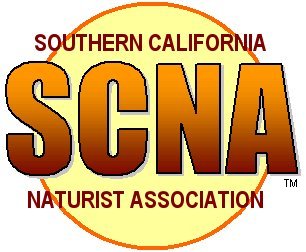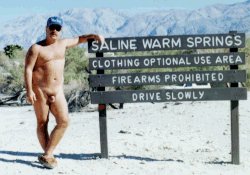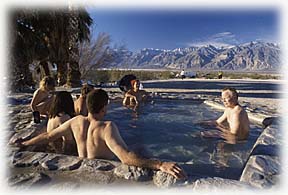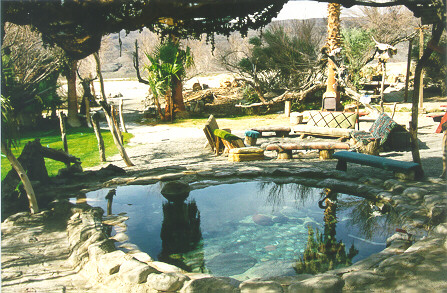January 2004
BACKGROUND
(Information compiled from the Naturist Guide to Southwest plus some on-line travelogue descriptions from visitors.)
This delightful but hard-to-reach natural hot springs has been visited by hearty campers and naturists for nearly a century.
During the 1960’s “Lizard” Lee Greenwood moved next to the springs and loosely supervised a series of 'improvements': he and other volunteers closed the source spring, built tubs from concrete and rock, and plumbed the source spring to the tubs as well as a bathing tub, shower, and wash sink. Today, volunteers clean out all tubs with bleach once a day. Visitors donate all supplies: toilet paper, wood for the community fire, bleach, cleaning utensils and supplies, etc.
“Most people I met there had visited often before and knew each other. When we had no music around the fire we told stories and jokes. I found about 30 people there when I visited (November 2000). Veterans expected 100-200 for Thanksgiving, the peak holiday. I never found a crowd at either pool and often had them to myself. I never had to wait to use the shower or washtub. People seem to spread out their use. A hundred might make a crowd.”
In 1994 Death Valley National Monument changed to Death Valley National Park and more than doubled in size as it added Saline and Eureka Valley west of it and other adjoining land. The BLM transferred authority to the National Park Service, but the area retained its CO tradition without hassle until now.
NOTE to SCNA readers: You should be aware also that since 1933 when Death Valley became a National Monument, the Timbisha Indian tribe was displaced, and to this day still has not found a new home. Current talks have focused on them taking Saline Valley. They object to nudity at the hot springs and say they would close it down. This could be the unspoken issue and the reason the Superintendent is now quietly trying to remove nudity from the area.
THE SITUATION NOW
On December 10, 2004, SCNA received an email from the Naturist Action Committee alerting our members to a sudden change in policy: the Clothing-Optional sign has been removed on the order of Park Superintendent James T. Reynolds, and his aide has been telling callers that the Code of Federal Regulations (CFR) forbids nudity at the Springs.
But the aide's information is incorrect. The Backcountry Wilderness Field Guide prepared in 2000 specifically by the staff of Death Valley National Park states:
"A 'clothing optional' practice has existed at the Saline Valley Warm Springs for several decades. Such activity is not prohibited under 36 CFR; however, certain sections of the California Penal Code could be applied if a complaint is lodged. The current policy of clothing optional use of the Saline Warm Springs will be allowed to continue; appropriate enforcement actions will be taken upon complaint."
The position of the Naturist Action Committee is that Superintendent Reynolds has authorized a move that is clearly a step backward from avoidance of user conflict and a radical departure from Park policy, as expressed in the Park's own Backcountry/Wilderness Field Guide.
NAC and SCNA asks all naturists and other concerned citizens to contact Superintendent Reynolds.
FOLLOWUP TO THIS ARTICLE:
PLEASE CEASE SENDING LETTERS, EMAILS, AND TELEPHONE CALLS TO SUPERINTENDENT REYNOLDS AS HE SAYS HE HAS HEARD OUR CASE "LOUD AND CLEAR."
Letter to all local naturist clubs dated February, 2005:
Superintendent J.T. Reynolds claims it was a U.S. Attorney, and not the
county's district attorney, who advised him to remove the signage. Reynolds won't
give the attorney's name, which certainly raises an eyebrow in these quarters.
Regardless, neither a U.S. Attorney's office nor the office of a local
district attorney has the authority to decide such matters of policy for the Park
Service or one of its units. The National Park Service has a staff of solicitors
that advise resource managers on such things. Superintendents don't need to be
acting precipitously on things like signage, based solely on the remarks of
unnamed sources.
The fact is that other NPS units have installed informational signage in
clothing optional areas without considering it an endorsement. A couple of
prominent examples are Gunnison Beach at Sandy Hook in the Gateway National
Recreation Area and Apollo Beach at Canaveral National Seashore. Both of those were
thoroughly vetted by NPS solicitors.
Unofficial policies are fine, but they can change with a change of personnel.
Further, with a spokesperson in the office of the superintendent telling the
public that the code of Federal Regulations forbids nudity in the park (it
doesn't), it's difficult to know just what policies, official or otherwise, are
being followed.
I'll have to take exception to the notion that "the lack of a sign isnt an
issue because the only people who go out there know what to expect." If that
were entirely so, then Supt. Reynolds would never have gotten the complaints he
claims he's received from visitors to the site. Informational signage helps
mitigate the presumption of recklessness in the behavior of those who choose to
be nude.
Perhaps more importantly from the viewpoint of park managers, it provides a
verifiably proven means of reducing user conflict, and it does so without
establishing endorsement. The Naturist Action Committee respectfully maintains that
the lack of a sign IS an issue for anyone giving thoughtful consideration to
the situation.
I hope the expanded discussion I've offered here helps put things into a bit clearer focus.
Bob Morton
Executive Director
Naturist Action Committee
UPDATE SEPTEMBER 2006:
As of this date, the "Clothing Optional Use Area" sign has not been put back up. Still, no further actions against the residents or visiting nudists has taken place. Eventually Superintendent Reynolds will move on, either by retirement or re-assignment (it may take a change in national administrations to accomplish this.) So the issue is not dead, just postponed until we can speak to some new faces in the future.







